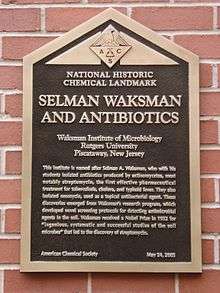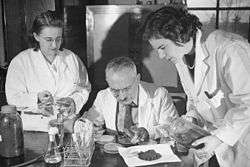Waksman Institute of Microbiology
The Waksman Institute of Microbiology is a research facility on the Busch Campus of Rutgers University. It is named after Selman Waksman, a student and then faculty member at Rutgers who won the Nobel Prize for Medicine in 1952 for research which led to the discovery of streptomycin. The institute conducts research on microbial molecular genetics, developmental molecular genetics, plant molecular genetics, and structural and computational biology.

The current director of the Institute is Professor Joachim Messing. He is the institute's fourth director.
History

A total of eighteen antibiotics were isolated in Waksman's laboratory at the New Jersey Agriculture Experimental Station at Rutgers University. Of these, streptomycin and neomycin, and actinomycin were commercialized. Streptomycin, in particular, was the first antibiotic to cure tuberculosis. Waksman used half of his personal royalties from patents for streptomycin to create the Foundation for Microbiology in 1951. The Foundation is a private organization that funds and supports microbiology research.
He requested money from the Foundation to create the Institute of Microbiology at Rutgers. The idea for an institute that focused on soil science first came from Waksman's mentor, Dr. Jacob Lipman, who taught Waksman when he was an undergraduate student and later became his colleague. The institute was founded in on June 7, 1954 with Waksman as its first director. He retired in 1958.[1]
References
- Lechevalier, Hubert A. (June 1988). "The Institute of Microbiology (1954-1984)" (PDF). The Journal of the Rutgers University Libraries. L (1). Retrieved 21 December 2014.
External links
Further reading
- Lechevalier, Hubert A. (June 1988). "The Institute of Microbiology (1954-1984)" (PDF). The Journal of the Rutgers University Libraries. L (1). Retrieved 21 December 2014.